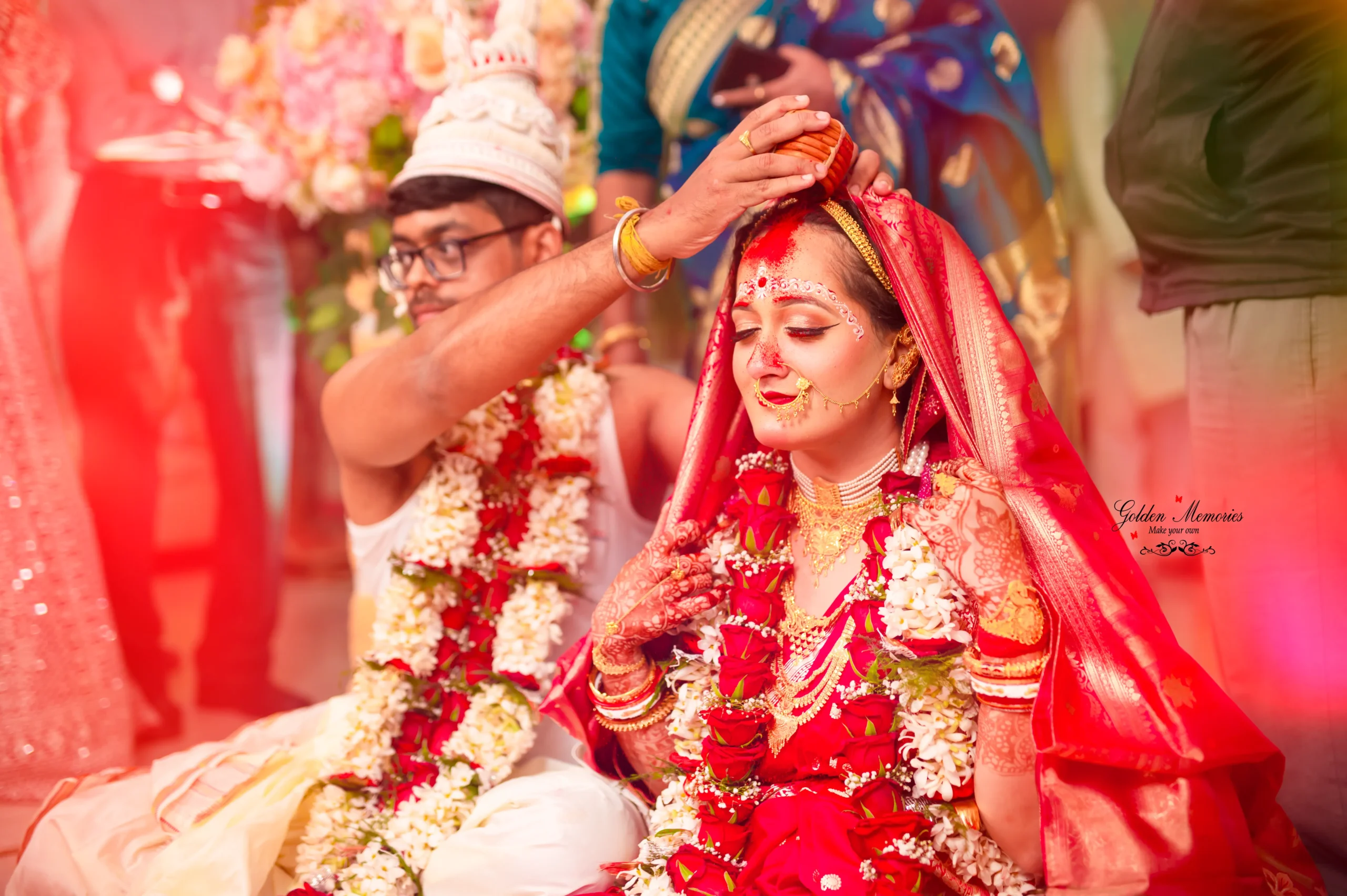If you’ve ever attended a Bengali wedding, you’ll know it’s not just a wedding it’s an emotion. It’s where traditions meet madness, where families laugh and cry together, and where every wedding ritual feels like a scene out of a storybook.
From the fragrance of ghee-lit diyas to the echo of the conch shell, from the bride’s shy smile behind betel leaves to cousins pulling pranks on the groom it’s a celebration like no other. These traditional Bengali wedding rituals are a living expression of Bengali culture, of family bonds, and of the joy of becoming a married woman and a new bride.
And the best part? It’s not just one day. A Bengali wedding is a 4–5 day festival of love a true grand wedding where each day offers numerous rituals: some playful, some deeply emotional, all absolutely unforgettable.
At Golden Memories as wedding photographers in kolkata who live and breathe wedding photography for traditional Bengali and Indian wedding ceremonies we’ve seen countless Bengali wedding rituals through our lenses. Trust us, no two ceremonies are the same. Each wedding venue, each wedding mandap, each family of the bride or groom brings its own voice and flavor to the day.
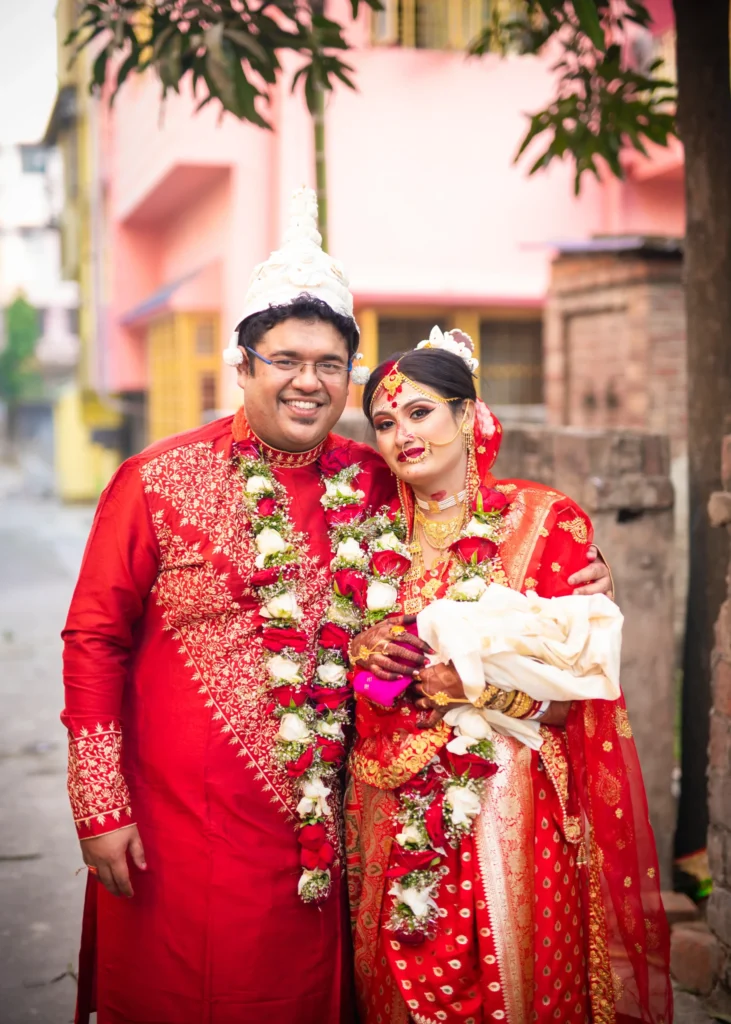
Quick List of Bengali Wedding Rituals
Bengali Pre-Wedding Rituals
- Ashirbaad – Blessings from family
- Aiburobhaat – Last meal as a bachelor/bachelorette
- Dodhi Mangal – Sacred morning meal and fasting
- Nandi Mukh – Paying homage to ancestors
- Gaye Holud – Turmeric ceremony
- Shankha & Pola – Sacred bangles for the bride
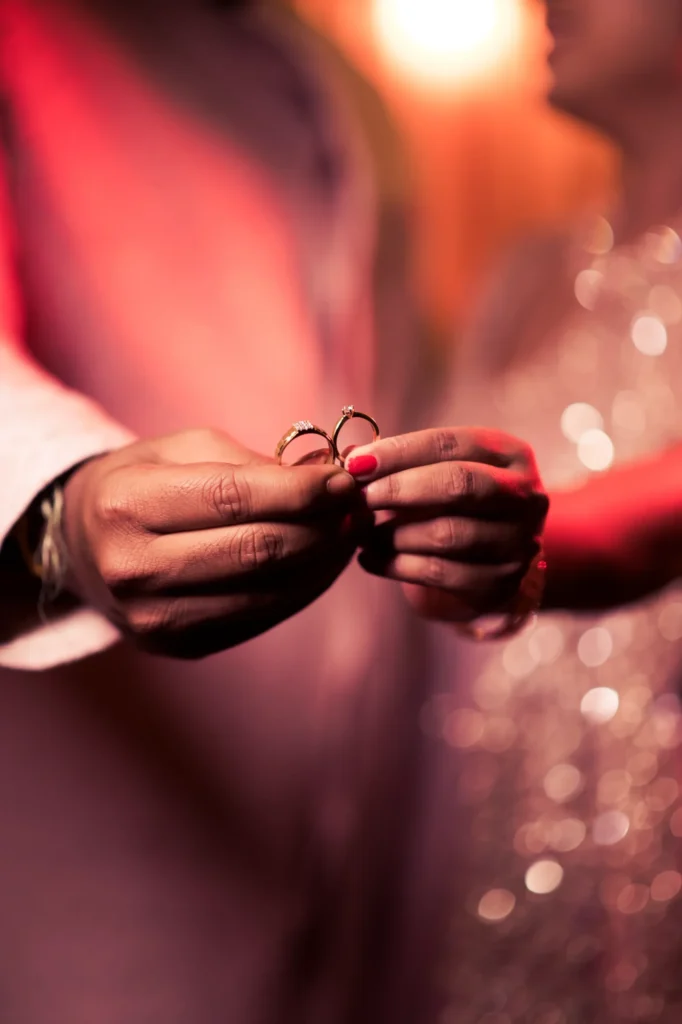
Wedding Day Rituals
- Bor Boron – Welcoming the groom
- Subho Drishti – First look of the couple
- Mala Bodol – Exchange of garlands
- Sampradan – Giving away the bride
- Yagna – Sacred fire ritual
- Saptapadi / Saat Paak – Seven rounds around the fire
- Anjali / Kusumdinge – Offering puffed rice to fire
- Sindoor Daan – Groom applies sindoor
- Biday – Farewell of the bride
Post-Wedding Rituals In Bengali Wedding
- Bodhu Boron – Welcoming bride to her new home
- Boubhat – First meal at groom’s home
- Phool Sajja – Decorating the bridal bed
Now, let’s walk step by step through the beauty of a Bengali wedding.
Recommended: Why a Pre-Wedding Photoshoot Matters
Pre-Wedding Rituals: The Beginning of a Beautiful Journey 🌸
Before the bride and groom even reach the mandap, the festivities are already in motion. These pre-wedding rituals are intimate, colorful, and often the most fun-filled part of the wedding.
1. Ashirbaad (The Blessing Ceremony)
This is where it all begins. Once the wedding date is fixed, both families come together to bless the bride and groom. Elders shower them with husked rice the groom are blessed with husked rice and other tokens and place durba and small gold ornaments on their foreheads. It’s a humble wedding ritual, but full of meaning.
What makes Ashirbaad unforgettable is the human detail: a grandmother whispering a blessing, a father quietly slipping a token into his child’s hand, the whole member of the family gathered around. It’s simple, intimate, and deeply moving.
2. Aiburobhaat (The Last Feast as a Bachelor/Bachelorette) 🍛
If Bengalis have one universal love, it’s food sweet and savory alike. Aiburobhaat is the last big family meal the day before the wedding or on the eve of the wedding where the family of the bride or the groom spoils them with a spread that would make any food lover swoon.
Think fish, rice, vegetable delicacies, chutneys, and mishti doi and lots of laughter. It’s the last big meal the bride or groom has with their childhood family. Brides have been known to joke that it’s their “official food coma before married life,” but the nostalgia in parents’ eyes is real: this pre-wedding ritual marks the end of an era and the start of a new bride’s life.
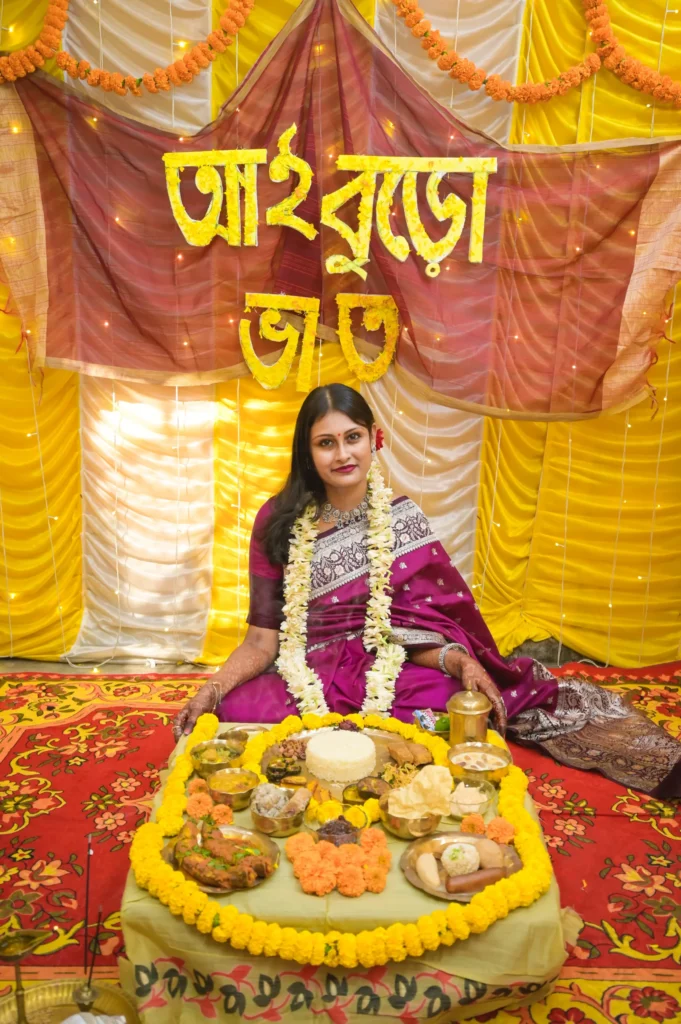
3. Dodhi Mangal (The Sacred Morning Meal) 🌅
On the morning of the wedding, just before the whirlwind of ceremonies, comes Dodhi Mangal. The bride and the groom are fed flattened rice soaked in milk and jaggery; after that, they fast until the wedding ceremony concludes. It’s a sweet, quiet start that symbolizes patience, purity, and discipline.
Families tease and make it light a cousin nudges the groom, “This is practice for all the patience you’ll need in married life.” But the ritual remains tender and private, a small island of calm on a very full day.
4. Nandi Mukh (Remembering the Ancestors) 🙏
A ritual of a Bengali wedding that binds past and present, Nandi Mukh is where the family invites ancestral blessings. The priest recites Vedic mantras; incense curls in the air; everyone falls into a quiet reverence. You can feel history in the room a sense that the union is witnessed by generations.
It’s one of those beautiful rituals that reminds everyone a wedding is more than two people it’s a continuation of family, lineage, and love.
5. Gaye Holud (Haldi Ceremony) 💛
Also called the haldi ceremony, Gaye Holud is one of the most joyful Bengali pre-wedding moments. The groom is smeared with turmeric (he might giggle, sit still as relatives drizzle turmeric), and then that same paste plus a new saree, gifts and sweets is taken to the bride’s home.
At the bride’s place, turmeric is applied to her face and hands, and laughter is everywhere. Mothers and cousins smear turmeric on each other, the conch shell sounds, and there’s candid chaos as everyone scrambles for a good photo. Turmeric is both blessing and beautifier a simple, glowing metaphor for starting married life fresh.
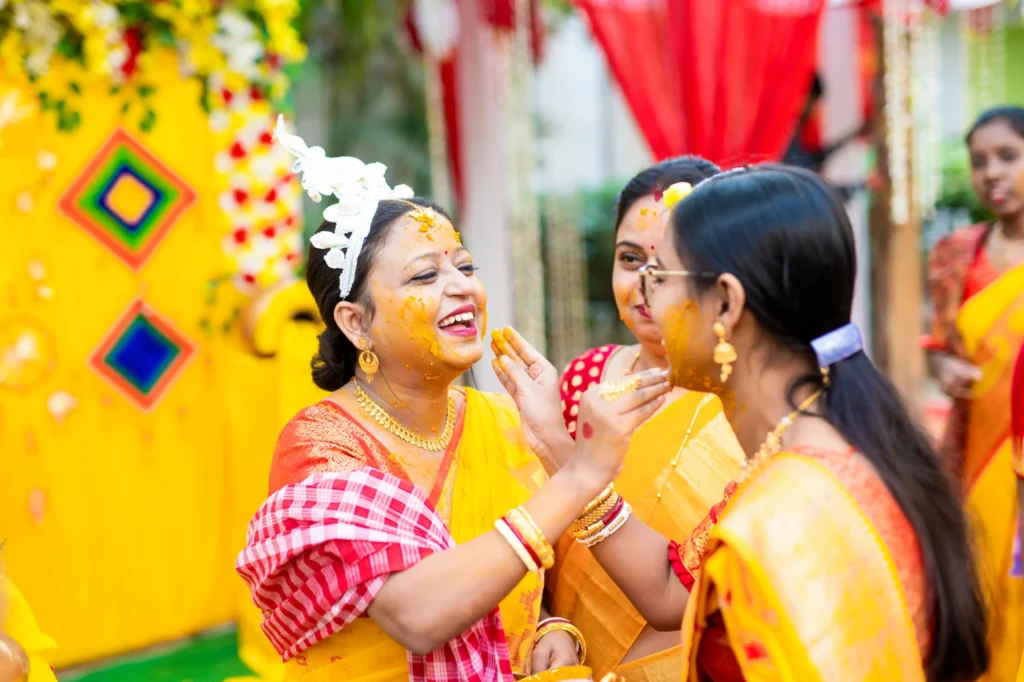
6. Shankha & Pola (The Sacred Bangles)
When the bangle ritual arrives, the room quiets. White shankha (conch shell bangles) and red pola (coral bangles) are placed on the bride’s wrists by her mother or an elder married woman. For the Bengali bride, these are symbols of marital bliss a tangible reminder that she has stepped into a new role as a married woman.
Every time she glances at them later, the new bride remembers the hush, the smile, and the blessing. These small ornaments carry enormous emotion.
Read More: Types of Wedding Photography: Exploring Different Wedding Photography Styles for Your Big Day
Wedding Day Rituals: The Big Day ❤️
Now comes the heart of it all the day of the wedding. The energy is electric, the rituals are meaningful, and emotions run deep.
7. Bor Boron (Welcoming the Groom)
The groom arrives to the wedding venue like a small king sometimes in a decorated car, sometimes in a horse-drawn carriage. The bride’s family gathers at the entrance to welcome him.
His arrival is playful and ceremonial: the bride’s mother performs an aarti and circles a lamp to ward off evil before touching tilak to his forehead. Meanwhile, cousins block the door (it’s a classic) and demand a “groom tax” some bargaining, jokes, and laughter before he’s allowed to step into the mandap.
It’s a beautiful mix of ritual and family mischief and a reminder that every wedding has its playful side.
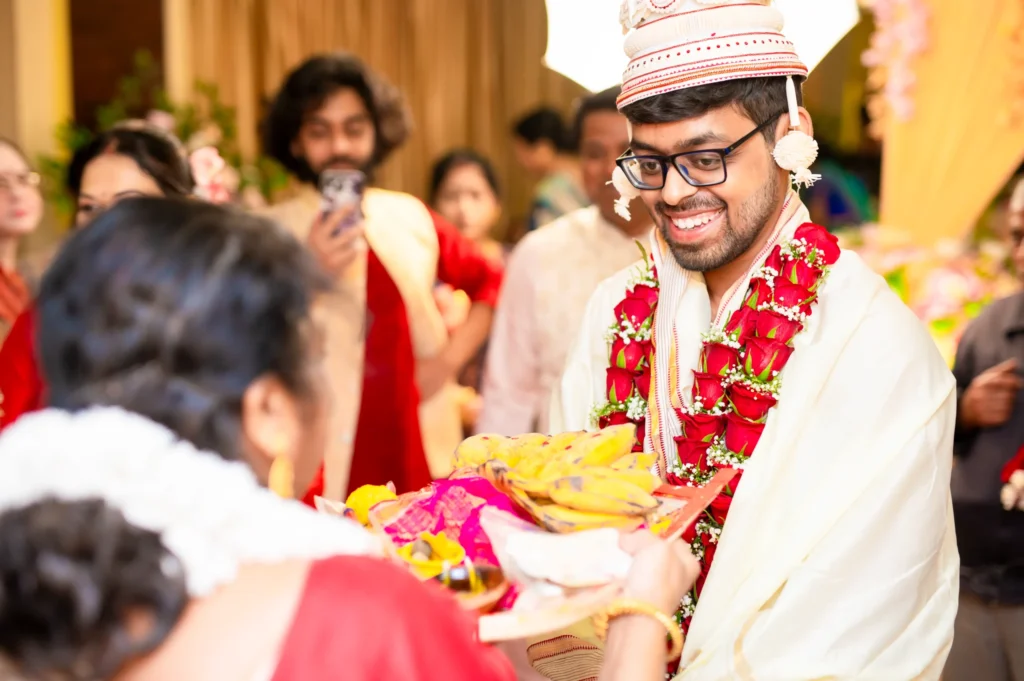
8. Subho Drishti (The First Look) 👀
One of the most intimate wedding rituals, Subho Drishti is the moment the bride and the groom look at each other for the first time on the wedding day. The bride is often carried in on a wooden stool (the pidi), with her face hidden behind betel leaves. As the ululation and conch shell sounds rise, she lowers the leaves and the couple locks eyes.
It’s shy, it’s electric, and it gives everyone goosebumps. The bride and groom look at each other with the whole family watching, and you can feel the union beginning to settle in their expressions.
9. Mala Bodol (Exchange of Garlands) 🌸
The garland exchange Mala Bodol is playful and symbolic. The couple exchanges garlands three times. Family members may lift the bride up, so the groom gets difficult time trying to place the garland which makes for hilarious moments when the groom struggles and the cousins cheer.
It’s light, it’s fun, and it shows that wedding tradition in Bengal loves a laugh alongside its solemn vows.
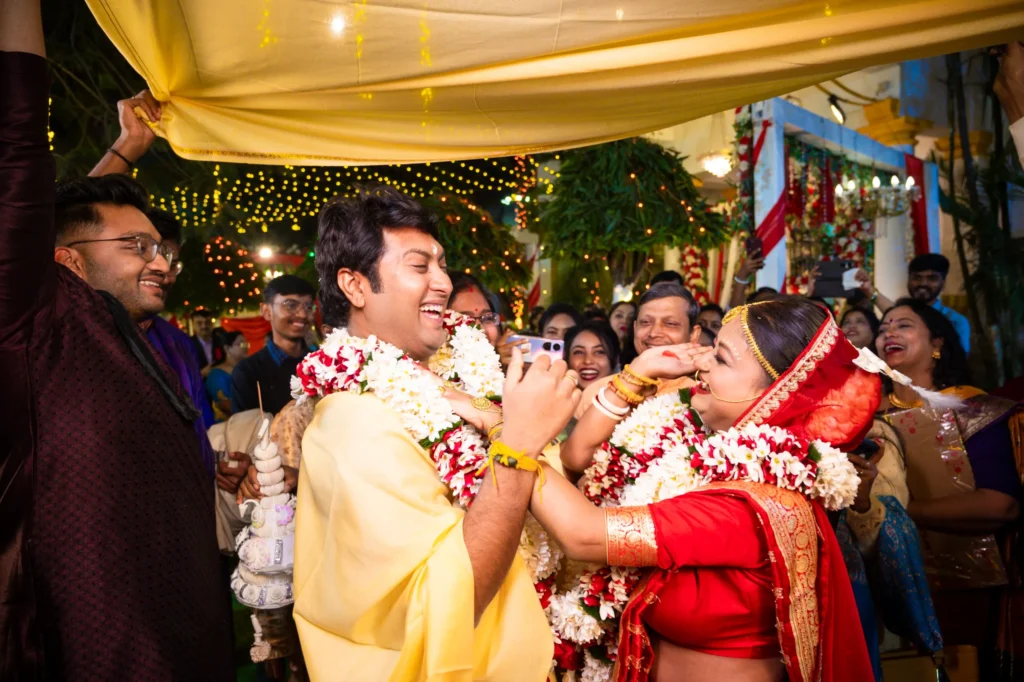
10. Sampradan (Giving Away the Bride)
Sampradan is where a member of the bride’s family usually her father or maternal uncle places her hand to the groom, officially entrusting her to the new family. The priest chants, the sacred fire flickers, and emotion is thick in the air.
For parents, it’s both a release and a blessing giving their daughter away and trusting she’ll be cared for as she becomes part of her husband’s family.
11. Yagna & Saat Paak / Saptapadi 🔥
At the wedding mandap, the couple sits before the sacred fire. Their garments are tied together, symbolizing the union of two lives. Then they perform Saptapadi the seven rounds around the fire. In many homes, those seven rounds can include the bride walking around the groom or both walking together around the fire, pledging seven vows.
This is one of the most important rituals of a Bengali wedding: each round is a promise to share joys, carry burdens, raise a family and stand by each other. The bride and groom then sit with the family as the priest completes mantras, and everyone breathes with relief and joy.
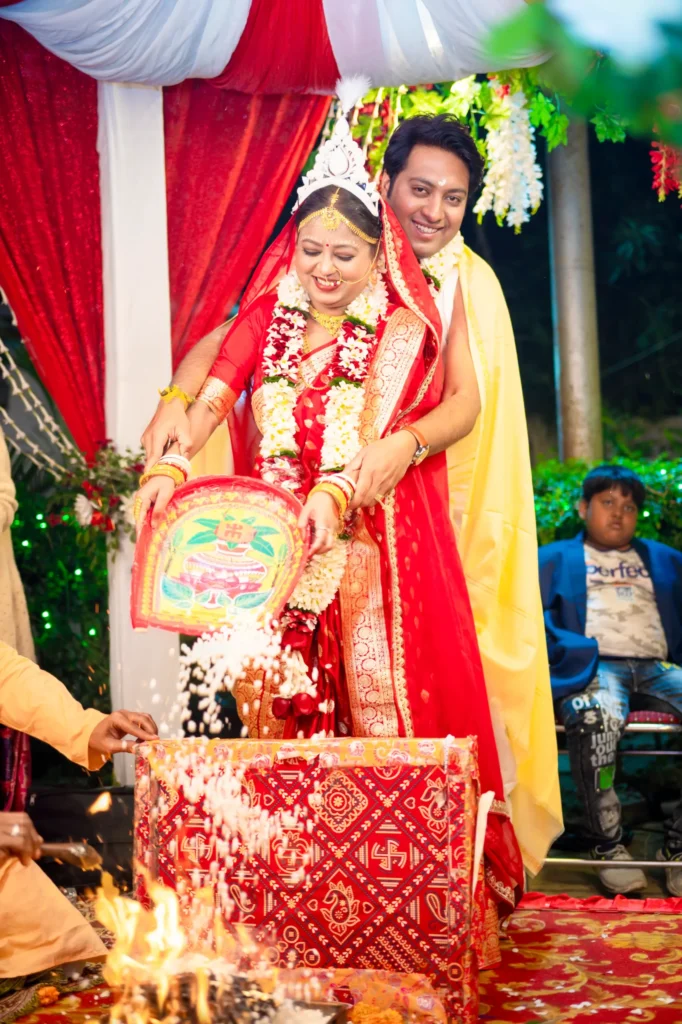
12. Anjali / Kusumdinge 🌾
A tender moment follows: the bride’s brother (or a close sibling) helps the bride offer puffed rice into the fire the puffed rice symbolizing prosperity. It’s a small act, but one that often brings tears a brother’s hand guiding his sister in a ritual that signals she’s moving to her new home.
The bride and groom then sit near the fire as relatives shower them with blessings, and the sense of family continuity is powerful.
13. Sindoor Daan (Vermilion Ceremony) 💍
Perhaps the most iconic image of a Bengali wedding, Sindoor Daan is the moment the groom applies sindoor along the bride’s hair parting. With a trembling hand, the groom smears the vermilion and the bride becomes a married woman visibly and joyfully.
The bride is usually draped in a new saree gifted by the groom’s family, completing the transformation. Cameras click, mothers wipe tears it’s both private and public, intimate and communal.
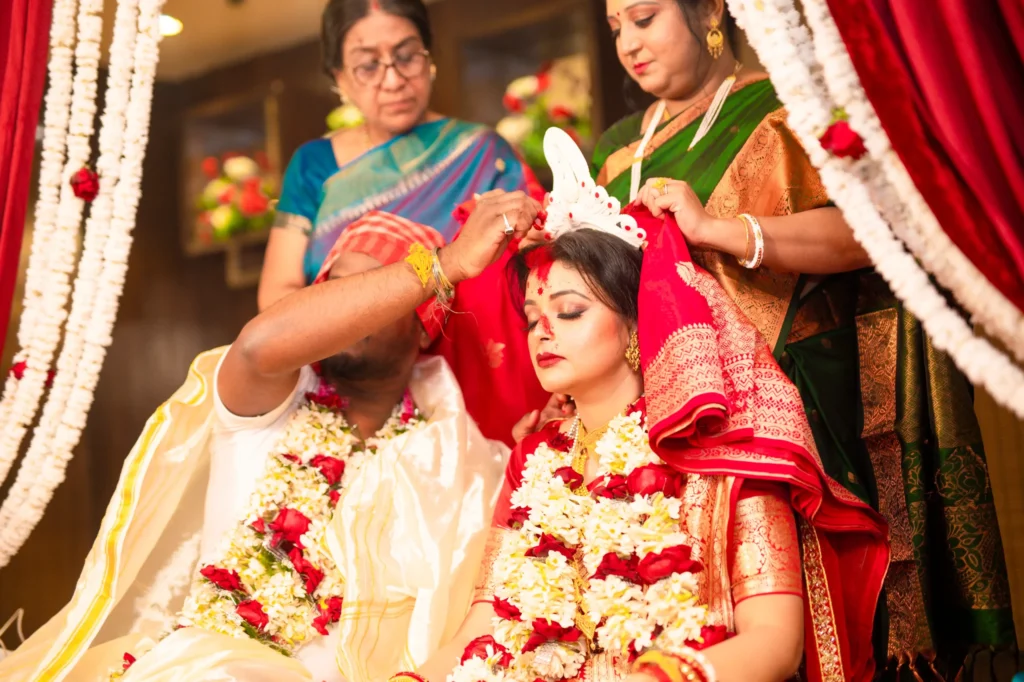
14. Biday (Farewell) 😢
The Biday marks the end of the wedding at the bride’s parental home and one of the most emotional rituals. The bride throws handfuls of rice behind her into her mother’s saree pallu a poignant gesture of gratitude. The house is loud with hugs and then suddenly quiet with farewells.
Even those who are familiar with traditional wedding endings admit: there’s rarely a dry eye. The daughter steps into a new life, but love and memory remain at home.
Post-Wedding Rituals: Welcoming the Bride 🌺
The wedding may have ended, but the story continues. Post-wedding customs welcome the bride into her new family with warmth and small, meaningful acts.
15. Bodhu Boron (Welcoming the Bride)
When the bride steps into her new home, she’s welcomed ceremonially often likened to Goddess Lakshmi entering the household. The mother-in-law performs an aarti, and the bride may step on a vessel filled with milk and alta, leaving red footprints on a white cloth. Those footprints symbolize prosperity walking into the family.
It’s a gentle, heartfelt ritual: the bride is welcomed, blessed, and shown her place among Bengali women in the household.
16. Boubhat (The First Meal)
The morning after, the groom offers the bride a plate a symbolic first meal the groom serves to his bride. Later, the family hosts a bigger boubhat, where the couple is officially introduced as husband and wife and guests shower them with gifts and best wishes.
Photographers love this time: the candid smiles, the playful teasing, the slow unwrapping of married life.
17. Phool Sajja (The First Night)
Finally, the phool sajja the bridal chamber is decorated with flowers. Jasmine, rose petals, tuberose scent and softness everywhere. Cousins tease, aunties giggle, and the couple shares privacy and gentle humor as they take the first steps of married life together.
It’s small and private, yet everyone in the family has an opinion and a story to tell about that night later.
Final Thoughts
A Bengali wedding isn’t just about two people getting married it’s about families becoming one, traditions being honored, and emotions flowing freely. From laughter during Mala Bodol to tears during Biday, every moment is unforgettable.
At Golden Memories, the best wedding photographer in Kolkata we aim to capture more than poses. We capture the little things: the groom holds the bride’s hand at the mandap, the bride’s brother slipping a smile as he helps with puffed rice, the white cloth with red footprints, the wooden stool where the bride sat before her Subho Drishti, the moment the groom smears turmeric during Gaye Holud, the instant when the groom offers the bride a plate during Boubhat.
You should feel the love, the madness, and the magic of your big day all over again. ❤️
These are not just rituals in Bengali weddings they are the heartbeat of family life, and they make every Bengali marriage unique and unforgettable.

